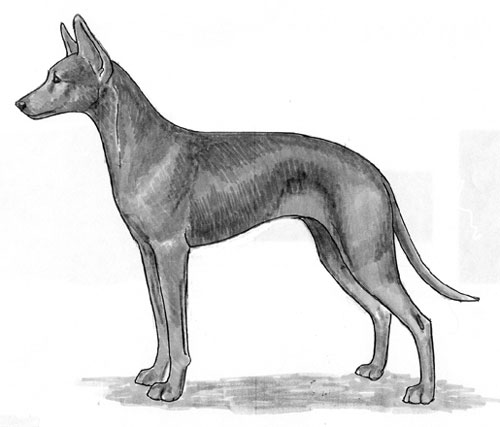Podenco Canario
Sighthound and Pariah Dog Group
The goals and purposes of this breed standard include: to furnish guidelines for breeders who wish to maintain the quality of their breed and to improve it; to advance this breed to a state of similarity throughout the world; and to act as a guide for judges.
Breeders and judges have the responsibility to avoid any conditions or exaggerations that are detrimental to the health, welfare, essence and soundness of this breed, and must take the responsibility to see that these are not perpetuated.
Any departure from the following should be considered a fault, and the seriousness with which the fault should be regarded should be in exact proportion to its degree and its effect upon the health and welfare of the dog and on the dog’s ability to perform its traditional work.
History
An ancient breed of Egyptian origin, its ancestors were probably brought to the Canary Islands by the Phoenicians, the Greeks, the Carthaginians and the Egyptians themselves. The breed dates back about seven thousand years. It hunts rabbits and ferrets by sight, scent and sound and has extraordinary survival skills.
The Podenco Canario was recognized by the United Kennel Club July 1, 2006.
General Appearance
A medium sized, slender, light breed that carries no excess fat. The ribs, spinal column and hip bones are readily apparent and the musculature is very lean and well developed.
Characteristics
Courageous, enthusiastic and energetic, not at all aggressive, and very attached to his master.
Head
Long and cone shaped, with parallel planes.
Serious Fault: Head excessively broad.
SKULL
The skull is flat, longer than wide, and has a marked occipital crest. The stop is barely marked.
Serious Fault: Excessive stop.
MUZZLE
Longer than the skull, shaped like a blunt cone. The lips are fine and tight, the same color as the nose.
Serious Fault: Pendulous lips.
TEETH
The Podenco Canario has a complete set of evenly spaced, white teeth meeting in a scissors bite.
Serious Fault: Absence of premolars.
NOSE
Large, and flesh colored.
EYES
Small, almond shaped, and obliquely set. Dark amber in color, the depth depending on the coat color. The expression is intelligent and noble.
EARS
Large and prick, broad at the set-on, and tapering to a point. At rest, they tip backwards.
Neck
Well muscled, straight, flexible and rounded, with no dewlap.
Forequarters
The angulation of the shoulder blade and upper arm is approximately 110 degrees.
FORELEGS
Perfectly vertical, straight and parallel with fine but solid bone. The feet generally turn slightly outwards.
Body
The body is slightly longer than tall. The chest is well developed but does not come down to the elbow. The sternum does not protrude in front of the point of the shoulder. The ribs are oval. The back is strong and the loin is somewhat elongated. The hipbones are visible. The belly is drawn up but not whippety.
Serious Fault: Protruding sternum.
Hindquarters
The angulation of the pelvis and femur matches that of the shoulder blade and upper arm.
HIND LEGS
The hind legs are vertical and straight with strong musculature. Angulation at the stifle is 120 degrees and at the hock it is 140 degrees. The hocks are quite high.
Serious Fault: Low hocks.
Feet
Cat feet with firm pads.
Tail
Set rather low and reaching just below the hock. It is carried hanging or in a sickle shape. It is a little tapered at the tip, which is generally white. The tail should never be curled or carried too high when moving.
Serious Fault: Rolled up tail.
Coat
Smooth, short, and dense.
Color
Any combination of red and white, with the red ranging from orange through mahogany.
Height
Height at the withers for males is from 21.5 to 25 inches. For females, it is 21 to 23.5 inches.
Gait
Agile, extended, and very light.
Disqualifications
(A dog with a Disqualification must not be considered for placement in a conformation event, and must be reported to UKC.)
Unilateral or bilateral cryptorchid.
Viciousness or extreme shyness.
Albinism.

Looking for a Dog?
Find a dog that will fit your family.
Note: The breeders on this list are not endorsed by UKC.
©Copyright 2006, United Kennel Club
